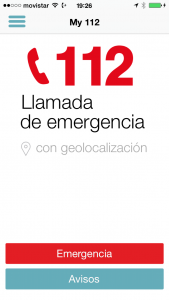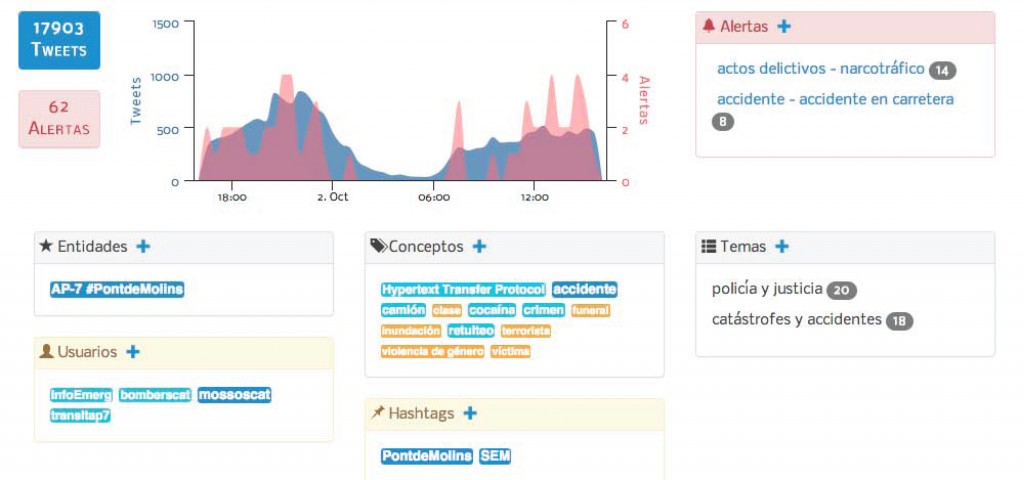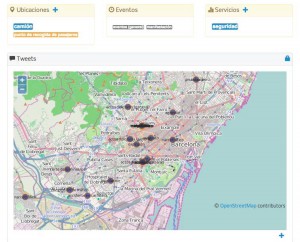Serving citizens without paying attention to social media?

The traditional access channels to the public emergency services (typically the phone number 112 in Europe) should be extended to the real-time analysis of social media (web 2.0 channels). This observation is the starting point of one of the lines which the Telefónica Group (a reference global provider of integrated systems for emergency management) has been working in, with a view to its integration in its SENECA platform.
Social dashboard for emergency management
At Daedalus (now MeaningCloud) we have been working for Telefónica in the development of a social dashboard that analyzes and organizes the information shared in social networks (Twitter, initially) before, during and after an incident of interest to emergency care services. From the functional point of view, this entails:
- Collecting the interactions (tweets) related to incidents in a given geographical area
- Classifying them according to the type of incident (gatherings, accidents, natural disasters…)
- Identifying the phase in the life cycle of the incident (alert or pre-incident, incident or post-incident)
Benefits for organizations that manage emergencies

Love Parade Duisburg
Anticipate incidents
Anticipation of events which, due to their unpredictability or unknown magnitude, should be object of further attention by the emergency services. Within this scenario are the events involving gatherings of people which are called, spread or simply commented through social networks (attendance to leisure or sport events, demonstrations, etc.). Predicting the dimensions and scope of these events is fundamental for planning the operations of different authorities. We recall in this respect the case of the disorders resulting from a birthday party called on Facebook in the Dutch town of Haren in 2012 or the tragedy of the Love Parade in Duisburg.

Flood in Elizondo, Navarre, 2014
Enrich the available information
Social networks enable the instant sharing of images and videos that are often sources of information of the utmost importance to know the conditions of an emergency scenario before the arrival of the assistance services. User-generated contents can be incorporated to an incident’s record in real time, in order to help clarify its magnitude, the exact location or an unknown perspective of the event.
Text Analytics technology

For the analysis of social content, the text analytics semantic technology (text mining) of MeaningCloud is employed. Its cloud services are used to:
- Identify the language of the message
- Classify the message according to a taxonomy (ontology) developed for this scenario (accidents of various kinds, assaults, natural disasters, gatherings, etc.)
- Extract the mentioned entities (names of people, organizations, places) and the message’s relevant concepts
- Identify the author or transmitter of each tweet.
- Extract the geographic location of the transmitter and the incident
- Extract the time of the message and the incident
- Classify the impact of the message
- Extract audiovisual (pictures and videos) and reference (links to web pages, attached documents…) material mentioned in the tweet for documenting the incident
- Group automatically the messages relating to a same incident within an open record
- Extract tag clouds related to incidents

 A multidimensional social perspective
A multidimensional social perspective
Text analytics components are integrated into a web application that constitutes a complete social dashboard offering three perspectives:
- Geographical perspective, with maps showing the location of the messages’ transmitters, with the possibility of zooming on specific areas.
- Temporal perspective: a timeline with the evolution of the impact of an incident on social networks, incorporating sentiment analysis.
- Record perspective: gathering all the information about an incident.


Telefónica and Daedalus (now MeaningCloud) at LT-Accelerate
Telefónica and Daedalus (now MeaningCloud) will jointly present these solutions at the LT-Accelerate conference (organized by LT-Innovate and Seth Grimes), which will be held in Brussels, on December 4 and 5, 2014. We invite you to join us and visit our stand as sponsor of this event. We will tell you how we use language processing technologies for the benefit of our customers in this and other industries.
Register at LT-Accelerate. It is the ideal forum in Europe for the users and customers (current or potential) of text analysis technologies.


Jose C. Gonzalez (@jc_gonzalez)
[Translation from Spanish by Luca de Filippis]






 A multidimensional social perspective
A multidimensional social perspective



